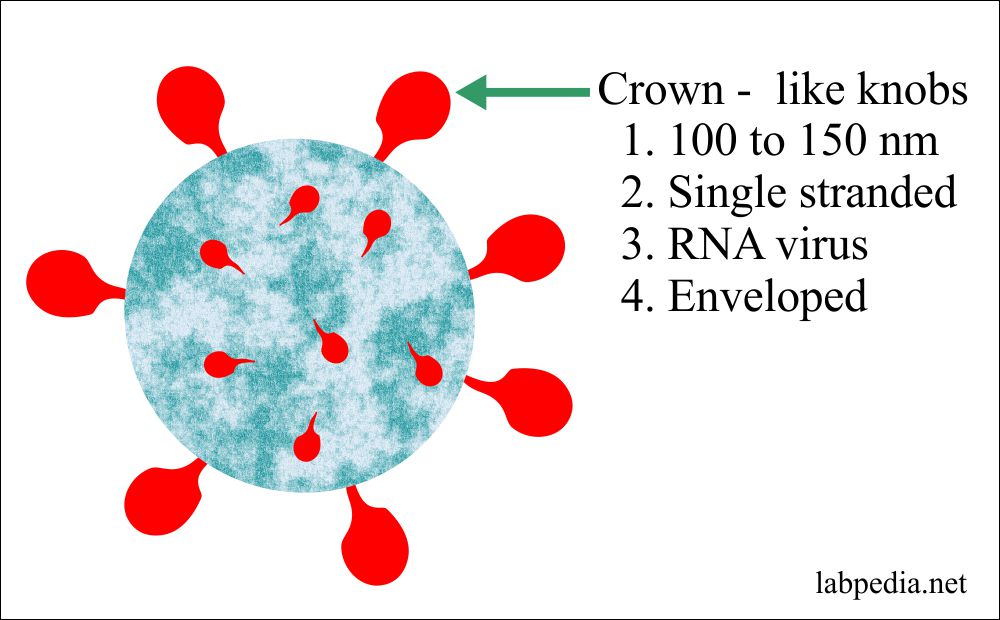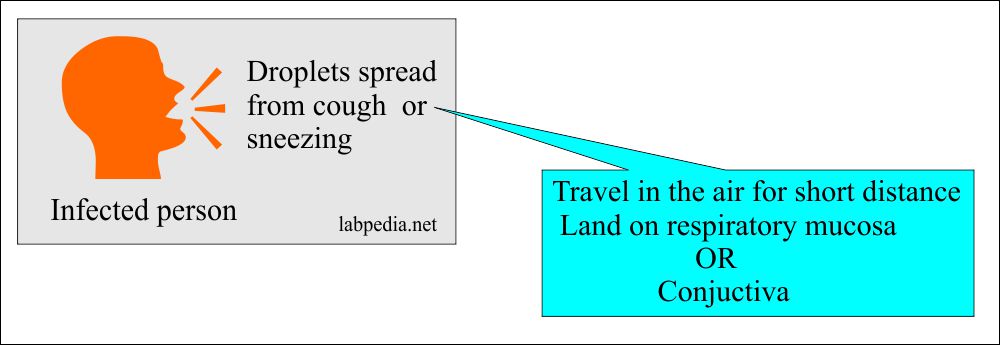Corona Virus VS Influenza Virus, COVID-19 Virus
Difference between Coronavirus (COVID-19) and Influenza virus:
Coronavirus (COVID-19) has similar signs and symptoms to H.influenza, and both are more common in the winter season.
Coronavirus is a single-stranded linear RNA virus. This gives S/S like the common cold.
No doubt that Coronavirus gives more severe disease than the Influenza virus.
Influenza virus:
- Influenza viruses are of three types A, B, and C. Type A infects humans, and the other two types infect mammals, swine, and birds. Type B and C are isolated from humans.
- Structure: Influenza virus measure 80 to 120 nm, enveloped single-stranded RNA virus.
- Influenza causes a self-limited disease. But it can cause pneumonia and serious illness in elderly patients.
- The incubation period is 2 days, and it may range from 1 to 4 days.
- It can resolve in 3 to 7 days.
- Still, there is a devastating Influenza infection in history in 1918, when 548,452 persons in the USA, 12.5 million people in India, and 20 million people worldwide died from the Influenza virus.
- The complication of Influenza:
- Older adults and immunocompromised patients may suffer severe complications and have pneumonia.
- This viral makes patients more susceptible to bacterial infections.
- These patients may have bacterial pneumonia with Staph. Aureus and Strep. pneumoniae.
- Diagnostic test for the Influenza infection:
- Isolation of the virus on culture. This will give genetic and antigenic analysis.
- Detection of the viral proteins and will help to decide the antiviral drugs.
- Diagnosing viral nucleic acid (RNA) by reverse transcriptase enzyme (PCR). This is a susceptible method.
- Serological test: Specific antibody >4 times the normal in 2 weeks.
- Vaccine for Influenza: The virus grows in chick embryos, which are then inactivated, purified, and used as vaccines.
- This vaccine contains Influenza A and B.
- The vaccines should be given to the elderly, immunocompromised people, and healthcare workers.
- The protection by vaccinations is around 70%.
Coronaviruses:
- Coronaviruses are 100 to 150 nm, enveloped, single-stranded viruses.
- These viruses are named because of their club-shaped surface projections, which resemble a crown.
- There are three respiratory coronaviruses.”
- Coronavirus 229E (α- coronavirus).
- Coronavirus NL63 (α- coronavirus).
- Coronavirus OC43 (β-coronavirus).
- Other viruses are:
- MERS-CoV is β-coronavirus that causes Middle East Respiratory Syndrome (MERS).
- SARS-CoV is β-coronavirus causes severe acute respiratory syndrome (SSRS).
- SARS-CoV-2 (the Novel coronavirus that caused coronavirus disease in the 2019 epidemic, so-called COVID-19).
- The most common viral infection in this epidemic was caused by 229E, NL63, OC43, and HKUI.
- These are the most common causes of the common cold.
- Coronaviruses give rise to 4% to 15% of respiratory diseases per year, and this may reach 35% at peak time.
- Most of the coronavirus infections occur in winter and early spring.
- But these cases are detected throughout the year.
- Immunity to infection is incomplete, and reinfection is common.
- Incubation period:
- The appearance of the common cold due to coronaviruses ranges from 2 to 5 days.
Signs and symptoms of Coronavirus:
A typical infection is presented as coryza (common cold) and can not be distinguished from other viruses.
Watch for the following S/S:
- History of fever and chills.
- There is a sore throat.
- There is congestion of the nose and congestion.
- The patient may have a cough.
- There is fatigue.
- Headache.
- Muscle or body pain and aches.
- Sore throat.
- Nausea and vomiting.
- There Ia loss of smell and taste.
- The patient will develop shortness of breath or difficulty in breathing.
- The patient may develop diarrhea.
SARS Coronaviruses
- SARS-CoV is a novel coronaviruses identified as a clinical syndrome.
- This was first identified as a cause of atypical pneumonia in Guangdong province, China, in November 2002.
- In the next 6 months, the virus spread to various parts of the world, 8000 cases were reported sick, and 774 patients died.
- The most affected countries were China, Hong Kong, Canada (Toronto), Taiwan, and Singapore.
- The source was animals, but the primary reservoir not certain. It was found in the living animals market.
- The spread of the SARS-CoV is efficient between humans.
- The most common mode of spread is personal close contact.
- This spread by the infectious droplets from the cough or sneezing from the infected person.
- Other modes of spreads are:
- Fomites.
- Contaminated hands (self-inoculation).
- Small particles in aerosols.
- Feco-ornal transmission.
- Transmission may take place through endotracheal intubation, bronchoscopy, and treatment with aerosolized medications.
- Person to person spread is more common in health care workers and hospitals.
- Spread not documented before the onset of symptoms or more than 10 days after the settling of fever.
- Clinical features:
- The incubation period is typically 2 to 7 days.
- In some cases, the incubation period maybe 10 days and rarely is 14 days.
- Chest X-Rays show evidence of pneumonia in 60% to 100% of the cases.
- Typically, the peripheral lung tissue’s involvement is unilateral (usually right lung), and there is no cavitation.
- There may be pleural effusion.
- There is lymphadenopathy.
- 67% of the case with normal X-Ray shows changes on high-resolution CT scan.
- Diagnosis:
- RNA detection by the RT-PCR (reverse transcriptase-PCR).
- The virus may be cultured.
- Serological tests.
- Viruses can be detected from the:
- Nasopharynx.
- Throat.
- Nose.
- Lower respiratory tract.
- This can also be found in the stool, serum, and plasma.
- Prognosis:
- 1/3 of the cases of corona improve clinically.
- The rest of the patients have a progressive disease with diarrhea, increasing tachypnea, shortness of breath.
- There are abnormal findings on pulmonary examination and X-Rays of the chest.
- 20% to 30% of patients need admission to the ICU. Usually, mechanical ventilation and roughly 10% may not survive.
- Death is usually due to respiratory failure, multiple organ failures, sepsis, or other complications.
- Prognosis is poor in older patients and with underlying disease.
The major differences between Coronaviruses and Influenza virus:
| Characteristic features | Coronavirus | Influenza virus |
| Type of virus | SARS-CoV-2 (RNA) | Influenza A, B, and C (RNA) |
| Disease | More severe (coryza like the common cold) | Less severe (flu) |
| Spread | Easy spread | Easy spread |
| Incubation period |
|
Short (1 to 4 days) |
| Signs and symptoms |
|
|
| Vaccines |
Yet not available (maybe available in December 2020 |
Available |


